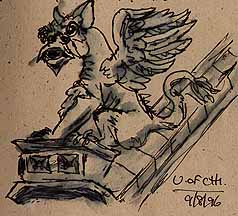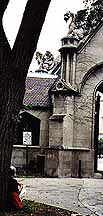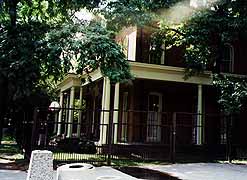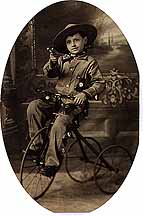American Sabbatical 009: 9/8/96
Chicago
9/8..To Chicago.
Here’s the yarn to date: Our bucolic episode in Michigan ended with a morning bike ride, then we saddled up and hit the pavement for Chicago. Our ambition for the day (Sunday) was to find a prototypical Midwest landscape to paint, so we sashayed down the secondaries rubber-necking at the views. Of course there is no TYPICAL landscape. We wanted to capture that sense of diminishing treelines in the blue distance, a few of the grand spreading solitary trees in the foreground, elaborate farm architecture, some silos, and maybe a long line of walking irrigators across the middle distance. HAH. We stopped and started, fussing over the perfect scene, until we were in the southwest corner of Michigan and merging into the highway flow. Then we stopped in the breakdown lane and snatched what scene we could. It’s a fascinating exercise to try and find the typical. You end up viewing EVERYTHING with intensity.
From there on out the intensity was strictly urban, as we did
the hotwheels highway hustle. We wooshed off the highway into
the Hyde Park section of Chicago to stay with Klara’s brother
in their home, and to visit with Josh and Laura. Both destinations
within blocks of each other.
Our first excursion from Klara’s was the three blocks into the University of Chicago campus. Grand Midwestern Gothic piles of sandstone with carved dragon gargoyles, lily ponds with goldfish, and lurking greenmen .. a very beautiful place. (To hear it told UChi is an embattled enclave surrounded by urban ghetto, and we’d expected something along the lines of Pratt Institute in BedSty. Chicagoans were constantly telling us to be careful to avoid this section or that. We, naturally, bumbled around expecting the worst. Chicago, on the other hand, smiled on us in hospitality. Even the “bad” neighborhoods we stumbled into didn’t seem scary. Maybe just lucky.) We ambled around the campus looking for the place where Leo met Priscilla (Peggy’s parents), and thought it a magic place for such an historic encounter.
Later we met Josh and Laura at a Japanese restaurant. It’s great
to see the youngsters grown into their skins, fully engaged in
life, with lively eyes and ready grins. Josh took us to a movie
up in the north end, so we had a brief guided tour of the heart
of the beast. How exalting it must have been for depression-era
folks to see towering skyscrapers rising over the horizon. The
big brag of tall buildings shining in the night still leave me
breathless, and echoes of the excitement in the Age of Steel are
still audible in the concrete canyons.

Griffon

Drawing Griffon
Since I left the Apple in the late sixties I’ve loathed cities.
Suddenly I wondered why. I realize that I’d come to associate
the metro with the anguished personal relations that we endured
in them. And, perhaps, I’d felt threatened by the very exalted
emotions they conjured up in me. The speed-rapping excitement
of citypeople spins me right out of my orbit. Or did, when my
center was less secure. Now I can feel the tugs of empathy, the
multiplicity of emotional demands, without getting swept away.
And it’s thrilling. Hey: cities can be a gas! All it takes is
a role as an observer, instead of a youthful desire to find a
place to fit, to make a Chicago wonderful fun.
The movie was “A Perfect Candidate”, a documentary about the Senate campaign of Ollie North. Now, I’d never have gone to a movie about Ollie North on my own hook. I mean, who cares? But this was a strikingly affecting flick. Whoever did the camera work was inside all the backrooms where no secrets were left unrevealed. I kept thinking, “these actors are terrific.” The smarmy demagoguery of all the candidates, the cynical attitudes of the operators (and the press), the stupidity of the electorate .. if you hadn’t gone in worried about the electoral process, you’d have come out chastened. There were no heroes in this movie except the film-makers. The culminating moment for me was when Ollie’s chief op was musing philosophical near the end, saying: “Winning elections is like smashing rocks. You try and break off a big piece of the electorate for your candidate, then smash the rest up into little pieces.” He goes on to say that governance is just the opposite process, it’s about putting coalitions together, compromising, unifying; and that the political process make governance virtually impossible. Nice work to be in.
(Memo #9)
Sept. 9 COMMUNITY - HULL HOUSE
Who? Jane Addams, social worker, peace activist
What? Hull House, first settlement house for urban immigrant community
Where? Chicago
When? 1889 to present
How? got upper class volunteers to live in, work, teach, offer
many services?
Topics: community, settlement house, progressivism, volunteerism,
noblesse oblige, J. Addams, T.Roosevelt, Toynbee, Tolstoy.
Questions: What makes a community? How do you best “help” a community?
What are our responsibilities to our community, to others? Does
the settlement house model still work?

Hull House
Today I fulfilled a longtime ambition: to visit Hull House, the
settlement house community center started on the west side of
Chicago by Jane Addams in 1889. Only 2 of the original 11 buildings
that were Hull House for so many years are standing. The rest
were taken down to make room for the new campus of the University
of Illinois-Chicago. The whole area, once full of crowded immigrant
apartments and houses, is open, with lowlying university buildings,
multi-level parking garages, three main expressways overhead and
industrial areas. We also saw one development of quite attractive
two story houses. There are also apartment houses here.
The Hull family mansion (that Jane Addams bought as her original
headquarters and used for activities and her own home until her
death in the 1930’s) is open to tourists. Across a small courtyard
with a fountain, given as a tribute to Jane Addams, is the brick
house that served as the residents’ dining hall. It is being renovated
to look as it did during its busy years. Today the upstairs is
used for a slide show and to house displays. The slide show showed
the many activities of Hull House in its heyday. There were models
of the full block square Hull House and of a typical building
on the West Side - many attached structures with incredibly crowded
conditions.
ORIGINS - Toynbee and Tolstoy. Jane Addams was born in northern
Illinois, into a comfortable family, educated at Rockford College.
She got started on her settlement house career by a visit to England
where she saw Arnold Toynbee’s prototype settlement house in eastern
London, where wellborn and educated English men and women served
to help the poor. Toynbee was a 19th century British historian
turned social activist. (His nephew Arnold J. Toynbee was an historian
also, in this century.) Addams was also influenced by the ideas
of Count Leo Tolstoy of Russian, the Russian writer and advocate
for the poor. Her activism was part of the great wave of reform
in the USA at the turn of the century that has become known as
progressivism, and is associated with Theodore Roosevelt.
Why progressivism? Why settlement houses? They were responses
to new ideas about people and society in the 1800s. The industrial
revolution and the notions of Charles Darwin combined to give
people the general idea that society could be improved, could
evolve into better forms, that machines and science could be used
to make life better in every way, more comfortable, more safe,
more hygienic. The promise of democracy added to this the notion
that everyone could benefit (although some Social Darwinists thought
that social classes showed a person’s ultimate worth and were
inevitable, so the rich were the deserving ones). Perhaps poverty
could be eradicated with education and services and knowledge.
The late 19th century saw a flood of immigrants enter the United
States - many from eastern Europe thronged to the cities. The
West Side of Chicago became home to dozens of nationalities. The
new immigrants were often poor and uneducated.
Jane Addams saw Chicago’s immigrant areas as needing a variety
of social services. Hull House was to provide them.
PHILOSOPHY- What comes across from the visits and the pictures
and the books is the combination of idealism and practicality
embedded in the Institution. Ideas about the rights and needs
of the ordinary person underlay it all.
Jane Addams believed in education . So Hull House offered a full
curriculum of courses for children and adults, from English citizenship
to history. The house also offered an educational atmosphere;
it sponsored a lecture series with luminaries such as Clarence
Darrow and Florence Kelley giving talks, and had reading rooms
with newspapers and books in many languages, from many countries.
Based on the belief that all people should have access to beauty
and the arts, Hull House had drama groups constantly performing,
a Hull House Chorus and band, courses in painting and ceramics,
demonstrations by local residents of ethnic arts (embroidery,
weaving, pottery). These last resulted in a museum where the gifts
of immigrants could be shown (I don’t know where the museum is
now sited).
Jane Addams also believed in vocational education and the improvement
of conditions for working people. There were classes in typing,
millinery, cooking. Hull House aimed to provide the knowledge
needed to improve health and life, so there were childcare classes
and nutrition-cooking classes.
In a very basic way, Jane Addams asked what people needed most.
General social services were provided in a number of ways. Hull
House has an incredible list of “first”s: first public baths,
first public playground, first public gym, first public kitchen,
first public swimming pool. Hull House pioneered day care and
kindergartens for the poor. Hull House bought a camp out of the
city on Lake Michigan and ran summer programs for poor children.
The staff of hull House is really a precursor of the Peace Corps
and Vista of the 1960’s, and Clinton’s Americorps. Volunteers
would apply and, if accepted, would live in small rooms at Hull
House for six weeks or so as a trial. They were basically given
room and board and would eat in the residents’ dining hall with
Jane Addams and other visiting luminaries. After their test period,
new volunteers were voted on by the rest of the staff . Some staff
members stayed on for years. It was part of the idea that the
educated and the wellborn had a responsibility to those who had
less (noblesse oblige). A variety of people served at Hull House
(including my great aunt Fanny Fogg) and provided role models
for the thousands they served as teachers, counselors, social
workers.
Jane Addams and Hull House were labor organizers, several unions
started there (The Women’s Shirtmakers, etc). They pushed for
reform through legislation by starting investigations into the
conditions of the poor, with research on truancy, sanitation,
infant mortality, drug use. Hull House produced reports that lead
to public outcry and legislative hearings.
Jane Addams was a public figure, friend to writers and philosophers
and presidents. In an amazing role for a woman at a time when
they couldn’t vote in national elections, she seconded Theodore
Roosevelt’s nomination for president as candidate of the third
party he organized in 1912 (the “Bull Moose” party). Jane Addams
also worked for women’s rights and world peace and was the first
American woman to receive the Nobel Peace Prize for the latter
work.
When nine of the original buildings were torn down, Hull House
decentralized. Today there are over twenty “Hull Houses” throughout
Chicago. Another time I’d love to visit them. Hull House is humbling.
So much was done there. I came away asking what more each of us
can do for our communities. With government funds shrinking, volunteerism
and local activism have to attack some of our problems.
Hull House and Jane Addams give us many precedents for community
work and activism. I realize how lucky Freeport is to have its
incredibly active Freeport Community Services, Adult Education
, the community players and many others. Today there’s a move
on for a YMCA which would provide another range of services for
Freeport residents. There was a group lobbying hard for a Teen
Center, there’s a group organized to create more lowcost housing.
My family has ties to Hull House, it turns out, on both sides.
My WASP great-aunt worked there and my immigrant father went for
the Saturday milk and cookies in the park. I see a Gibson girl
handing a small boy a glass not knowing he would marry her niece.

Leo